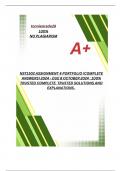, QUESTION 1 Energy Basics [18 marks] 1.1 Define and explain the different
forms of energy, providing real-world examples for each. (Focus on the
following forms of energy; Kinetic energy; potential energy; thermal energy;
chemical energy; electrical energy, light energy, and sound energy). (14) 1.2
Discuss the concept of energy transformation, giving examples of how one
form of energy can be converted into another. (4)
1.1 Forms of Energy
Energy is the ability to do work or cause change, and it exists in various forms that can be
converted from one to another. Below are the different forms of energy, with definitions and
real-world examples:
1. Kinetic Energy
Definition: Kinetic energy is the energy of an object due to its motion. The amount of kinetic
energy an object has depends on its mass and speed.
Formula: KE=12mv2KE = \frac{1}{2}mv^2KE=21mv2, where mmm is mass and vvv
is velocity.
Example: A car moving at high speed has kinetic energy. The faster the car moves, the
more kinetic energy it has.
2. Potential Energy
Definition: Potential energy is the energy stored in an object because of its position or state.
There are different types of potential energy, such as gravitational potential energy and elastic
potential energy.
Example: A rock perched on a cliff has gravitational potential energy due to its height
above the ground. If the rock falls, this potential energy is converted to kinetic energy.
3. Thermal Energy
Definition: Thermal energy, or heat energy, is the energy that comes from the movement of
particles in an object. The faster the particles move, the more thermal energy the object has.
Example: A cup of hot coffee has thermal energy because the molecules in the liquid are
moving rapidly. As the coffee cools down, the thermal energy decreases.
4. Chemical Energy
Definition: Chemical energy is the energy stored in the bonds of atoms and molecules. This
energy is released or absorbed during chemical reactions.





